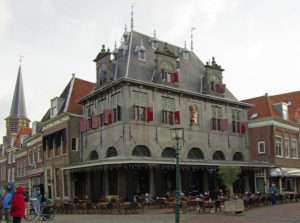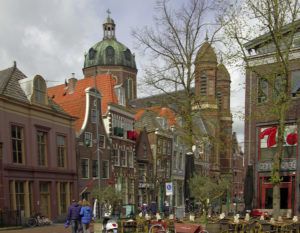Hoorn is a very attractive town which is on nearly every tourist itinerary as it has a lot of lovely old houses as well as canals.
In the C17th Hoorn was a very wealthy town and one of the ports used by the Dutch East India Company, which traded all round the world. The brick houses built at the time reflect the prosperity of the merchants.
Hoorn’s fortunes declined during the C18th and it relied on the fishing fleet for its prosperity. Following the Napoleonic Wars, it turned its back on the sea and focused on agricultural produce and cattle, becoming the market centre for the surrounding area. After the completion of the great dyke across the Markermeer and Ijsselmeer, it lost its access to sea borne trade. The harbour areas are now used as a marina for sailing ships.
During the 1960s, Hoorn was designated as an ‘overflow’ city and is now a commuter town for Amsterdam, with a lot of modern development around the edges of the town.
The town centre is compact with many C16th and C17th buildings around Roode Steen, the main square. This is dominated by De Waag, the weighing house built in where the cheese was weighed. Opposite is the Statencollege, the former town hall, built in 1632 and now part of the Westfries Museum (open afternoons) next to it.
The three mains streets, Grote Nord, Grote Oost and Nieuwstraat, radiating out from Rode Steen repay exploring with their mix of C17th and C18th houses belonging to wealthy seamen and also shops. The Saturday market on Niewstraat is fascinating. The baker’s was doing a roaring trade and was selling so many different kinds and varieties of bread as well as sweet stuff. Next to it, the pet stall was selling the largest dog bones I’ve ever seen.
To the south is Oude Doelenkade, which runs along the side of Binnehaven, where small sailing ships are moored. This is lined by a mix of old and modern houses. Many of the old houses tilt forward, which may have facilitated the lifting of goods into the attics.
At the end is Hoofdtorer, which was built in the C16th to guard the access to the port. This originally had a light beacon at the top to guide ships. It is now a restaurant.
On the harbour wall near the Hoofdtoren are three bronze statues of the Bontekoe ship boys. Bontekoe was the skipper of one of the Dutch East India Company ships. Hajo, Padde and Rolf were cabin boys on the voyage. During the voyage, a cask of brandy was accidentally set on light and this caused the gunpowder magazine to explode and sink the ship. The survivors survived on fish and birds they caught and rain water. The crew got so hungry they agreed to kill the three ship boys although it was agreed they would wait three more days. Fortunately for the boys, the lifeboat reached land and they were saved. Their story might have been forgotten if the log kept by Bontekoe hadn’t been turned into a popular children’s book and also a film.
This is a lovely old town and very photogenic. There are a lot more pictures “here.”:http://wasleys.org.uk/eleanor/otherholidays/holland/day_four/index.html















